Caribbean
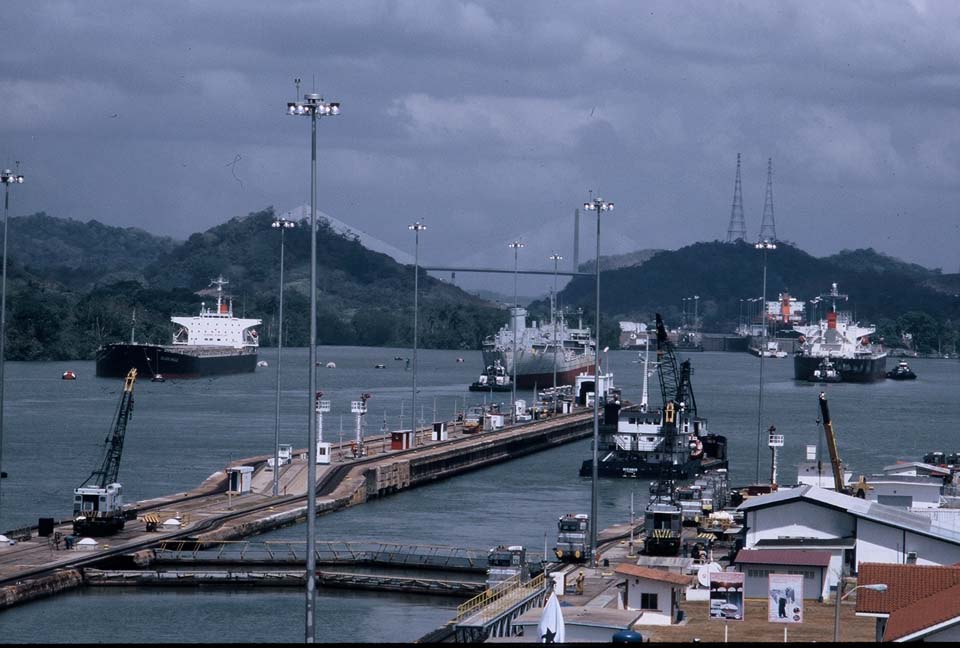
Panama Canal, Miraflores locks, Interamericana bridge in the background (WS)
Geographically, the West Indies form a 3300 km long island chain extending in a soft bow from the Mexican peninsula Yucatan to the mouth of the Orinoco River in Venezuela. They form the rest of a volcanic mountain ridge with tropical climate, reaching in Haiti a summit of 3,140 metres (Mt. Loma Tima) above sea level, facing a seabed far down to 8,300 metres (Virgin Depth) separating the Caribbean Sea against the Atlantic Ocean. The Great Antilles consist of Cuba, Jamaica, Haiti and Puerto Rico, as the Minor Antilles is designated the island chain from the Virgin Islands to Trinidad and Tobago. The encounter of hot continental and cool maritime air streams make the Caribbean to the weather kitchen for the frightened hurricanes.
On four adventurous voyages Christopher Columbus discovered and investigated the island world between 1492 and 1504. Believing having found Indian territories, he called them West India. In 1525 the Spanish conquistador Pedro de Alverado subdued the native residents of Central America. Only in 1821, seven provinces declared their independence and founded two years later the United States of Central America, but internal struggles led to separation in the independent republics. The rest of the Spanish colonies, Cuba and Puerto Rico, had to be ceded to the U.S.A. after the war of 1898. Saint Thomas, belonging to the Virgin Islands, had become in 1671 a Danish settlement. In the 19th century the main station of the British Royal Mail, it was ceded to the United States in 1917 by sale.
British Mail
After Spain got lost of her overseas possessions, the Bermudas, Bahamas, Jamaica and most of all the islands down to Trinidad off-shore of the Venezuelan coast had been subdued to British colonial administration. British sailing vessels took care of connection between the islands and the motherland and were responsible for forwarding of the Mail.
A British pioneer of shipping was William Wheelwright, who got in 1835 the exclusive steam shipping rights in Chilean waters. He founded in 1838 the Pacific Steam Navigation Co. or PSNC in London. James MacQueen, a Scotchman, who, yet under the age of 20, managed a sugar plantation in Grenada, achieved in 1839 the foundation of the Royal Mail Steam Packet Co. or RMSP in London. One of the founding members was George Brown, the first chairman of the PSNC, causing that both companies became interlinked from the beginning. In 1839 a Royal Charter and in 1840 a mail contract for services between the Caribbean, Canada and England was granted to the RMSP. In 1841 the schooners "Lee" and "Liffey" sailed to take up station in the West Indies. The first mail voyages from Southampton to the Caribbean were undertaken in 1842 by the steamers "Thames" and "Tay". In 1847 Brunel's "Great Western" was added to the expanding fleet. During the early age of steam shipping, Hendschel's Telegraph of 1856 pointed out British mail steamer services fortnightly on a route Southampton - St. Thomas - Puerto Rico - Jacmel (Haiti) - Jamaica - Chagres, the starting-point of the railway across the Isthmus of Panama. Further services were initiated from Puerto Rico to the Antilles as far as Trinidad and Tobago. Branch lines served Nassau (Bermudas), alternatively Havana - Vera Cruz - Tampico (Mexico) or Honduras. In 1854 appeared the first iron-hulled ocean mail steamer, the "Atrato". In 1900, the colour scheme of the RMSP changed from a black to buff funnel. In the beginning of the 20th century, the timetable listed the routes from Southampton to Kingston (Jamaica), Colon (Panama), to the Antilles and Venezuela by RMSP and PSNC. The homeward sailing terminated at Plymouth in order to cut the traveling time to London. At Colon, the Panama Rail Road, completed in 1854, provided a connection to the Pacific.
in the 19th century also the West India & Pacific Steamship Co. provided services from Liverpool to New Orleans, Mexican ports, Jamaica and Colon. Later, dissatisfaction with RMSP's Jamaica route caused the formation of the Imperial Direct West India Line. RMSP answered in 1905 by extending its services from Colon, northward to New York. Before WWI, RMSP and PSNC served New York. In connection with the Panama Rail Road and the PSNC South American West Coast steamers, a link between the U.S. East Coast and Chile was established. In 1913 RMSP got a contract for an additional Halifax - Antilles route. During WWI RMSP's Southampton - Caribbean services were interrupted, but ships borrowed from PSNC kept running between New York and Colon.
A substantial change in shipping routes worldwide was achieved with opening of the Panama Canal on 15th August 1914 - see chapter Pacific / Via Panama. The Southampton - West Indies services of the RMSP became replaced in 1920. C.R. Vernon Gibbs ("British Passenger Liners of the five Oceans") pointed out: "The reason lay in opening of the Panama Canal and creation of a Royal Mail shipping group of which the Pacific S.N. Company had become a member. The PSNC Liverpool - Valparaiso liners were re-routed through the Canal which they reached via Bermuda, Jamaica, Venezuelan and Colombian ports whilst New York services of that company catered for United States passengers (...) Purchase of the Pacific S.N. Company in 1910 brought together Britain's two chief South American shipping links...". In 1931 the mighty RMSP suffered its collapse - see the next chapter.
Caribbean and Pacific services became the domain of the PSNC. In 1931 they introduced on the Liverpool - Panama - Valparaiso route the innovative motor-ship "Reina del Pacifico" (17,702 gt). In 1938 the reconstituted Royal Mail Lines bought the PSNC, preserved however its identity. After WWII the white ships of the Royal Mail Lines had completely replaced the black/white ones of the former RMSP. At the end of the '50s remained only passenger-cargo services, and in 1965 the ships were acquired by Furness, Withy & Co. When the epoch of the ocean liners ended, the "Reina del Mar" (21,501 gt) was refurbished in 1964 for cruises by the Union Castle Line after she had served the line Liverpool - Valparaiso via the Panama Canal during eight years. Then only some passenger-cargo ships of Elders & Fyffes ran from Southampton to Trinidad and Jamaica.
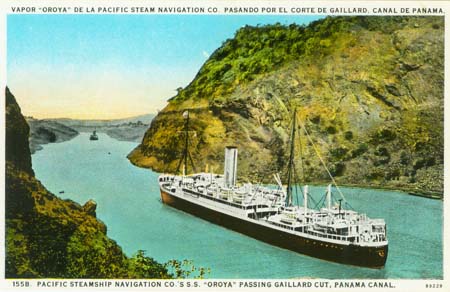
"Oroya", PSNC, passing Gaillard Cut (old card, coll. WS)
|
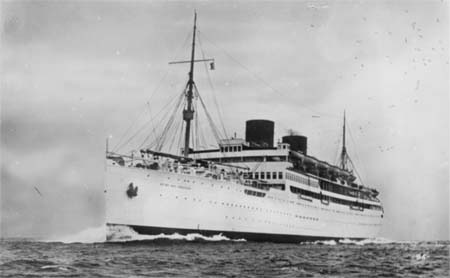
"Reina del Pacifico" of 1931, PSNC (old card, coll. WS)
|
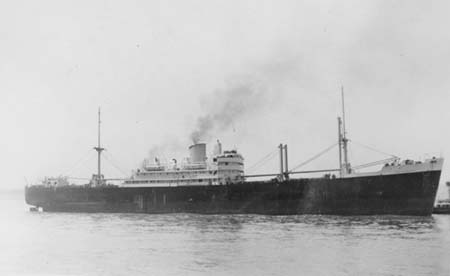
"Salaverry", PSNC (old card, coll. WS)
|
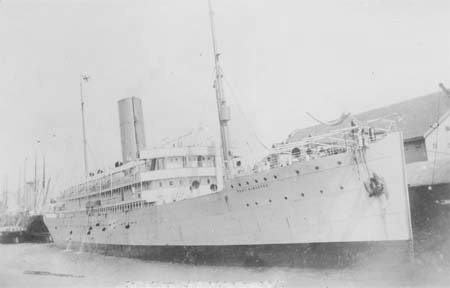
"Port Kingston" of 1904, Imperial Direct West India Line of Elder Dempster (old card, coll. WS)
|
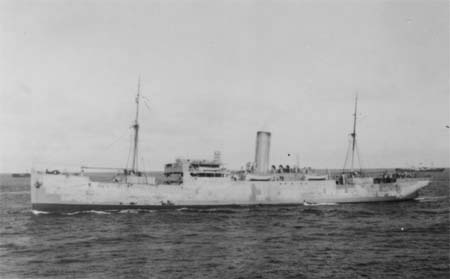
"Chagres" of Elders & Fyffes, around 1940 (old card, coll. WS)
|
|
American Expansion
After the end of the Mexican War of 1846-48, the annexed territories of California became a part of the USA. In the year before, the Mail Steamer Bill for a mail route from the East Coast via the Isthmus of Panama to the West of the United States was signed by the Congress. In 1848 the Senate of New York incorporated the Pacific Mail Steamship Co. or PMSSCo and its first president became William Henry Aspinwall, highly respected as a philanthropist. In 1848 the wooden paddle steamer "California" took up services between Panama and Oregon. In 1849 the 1,400-ton "Sarah Sands", the second large iron screw vessel (after the Brunel's "Great Britain") went to the Pacific where she took up Panama - San Francisco services on behalf of the PMSSCo (in 1852 she was sent to Sydney and sold). As the company was positioned to cash in for the Gold Rush, starting mainly in 1849, they had running no less than 18 steamers in the first five years. The East Coast of the USA was connected with the Isthmus of Panama around 1849 by the New York - Chagres Line of Howland & Aspinwall. With the Gold Rush, competition arose. Also the Atlantic & Pacific SS Co. , the New York & San Francisco SS Co. , the North American SS Co. , the New York Galway Line, the Central American Transit Co. and Charles Morgan with a New York - Nicaragua service showed their houseflag on these routes in the 19th century. Atlantic steamers of Cornelius Vanderbilt served the Isthmus, but Vanderbilt provided already before a route crossing Nicaragua by boat and stage coach, connecting with his San Francisco steamers.
Crossing the Isthmus of Panama on the way to the American West Coast meant a difficult journey. Canoes on the Chagres river brought the travelers to Gorgona, where they had to change to mules for the ride to Panama on RMSP's road. Construction of the Panama Rail Road brought a substantial amelioration. Aspinwall's United States Mail SS Co. with their New York - Chagres route carried labour force for building that railway. Construction started in 1850 at Gorgona, but soon it was decided to chose the coastal port as the terminus Aspinwall, now the city of Colon. The Panama Rail Road Co. received the exclusive construction rights and the line was completed in 1854. That broad-gauge railway was controlled in part by Aspinwall but also the RMSP held a financial interest in the company. A traveler had described the city Aspinwall in 1853: "Nobody dares to walk in the streets or to stay in a hotel without being well armed". On the first section trains started in 1851 and the first through train did run in 1855.
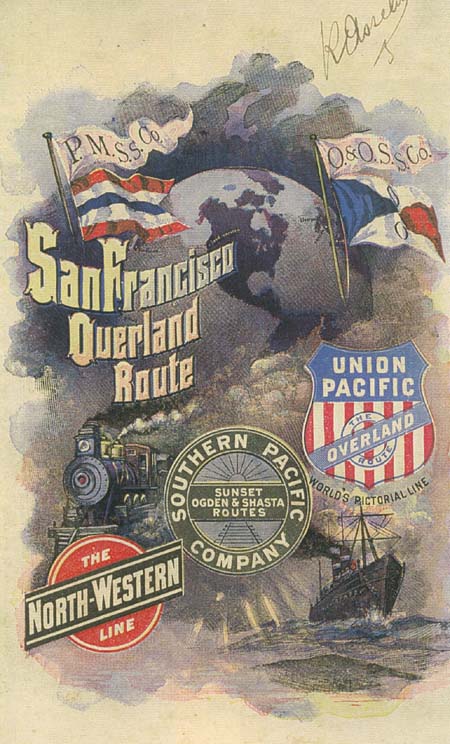
Ad in favour of the Overland Route (coll. Arthur D. Dubin)
|
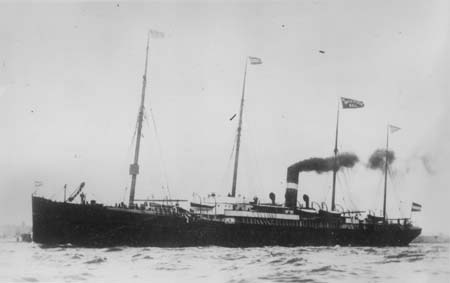
"Obdam" of 1880 with United States Mail flag, North American SS Co?? (old card, coll. WS)
|
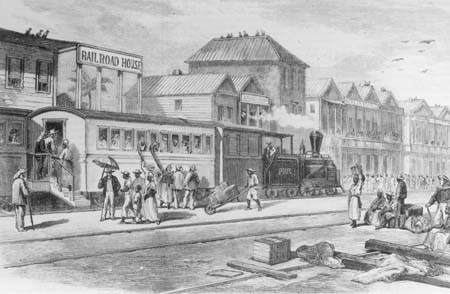
Panama Rail Road, Aspinwall station (contemporary publication)
|
At the outbreak of WWI an advertisement of the Panama Rail Road Co. listed the connecting steamer services departing from the Balboa harbour of Panama City close to the Panama R.R.Co's Balboa Terminal: The PMSSCo linked Central America, Mexico and San Francisco, whereas the PSNC, the Cia Sud-Americana de Vapores and the Cia. Peruana de Vapores served "intermediate ports to Valparaiso".
The completion of the first transcontinental railway through the USA in 1869 has meant a severe recession for the shipping companies. The new overland connection from coast to coast cut the traveling time from 100 to 120 days at the best gradually to less than a fortnight. The mighty PMSSCo had begun to suffer from competition also on their Pacific route sector, mainly by the Occidental and Oriental SS Co. In 1893 the PMSSCo was taken over by the Southern Pacific Railroad Co. Together with this railway the PMSSCo was acquired by railroad tycoon Edward A. Harriman in 1901.
As the Congress banned in 1912 railway companies' ships from the Panama Canal, opened in 1914, PMSSCo was sold to the Grace Line in 1916. That company, founded in 1865 by the Grace brothers of Ireland, started passenger-cargo services California - South America around 1913, followed by a passenger service from New York to the west coast of South America via the Panama Canal in 1916. Between the wars, Grace Line provided services New York - Panama - Chile. The history of the PMSSCo came to an end with the takeover by the Dollar Line in 1924 - see chapter Pacific.
A map in "The Official Guide" of 1916 showed routes of the California Atlantic SS Co. and the American Hawaian SS Co. New York - California, the Panama Rail Road Steamship Line New York - Cristobal, the United Fruit Co. to Jamaica, the Clyde Line to Santo Domingo, the Red 'D' Line to Venezuela, the New York & Porto Rico SS Co. , the New York & Cuba Mail SS Co., Munson Steamship Line and Ward Line to the Gulf and Cuba. Only in 1920 the latter company provided also a service Spain - Cuba. There were other companies, too, e.g. the Mexico Steamship Co. , which lost the "Mexico City" (ex "Narrung" of P&O) in 1918 in the Irish Sea.
Compared to the Panama Canal, the overland route crossing Mexico by rail between Coatzacoalcos and Salina Cruz was of minor importance. According to the Guide of 1916, steamers of the Ward Line, of the RMSP, passenger-cargo ships of the Cuban Line and Leyland Line from England as well as the French Line, Hapag and Cia. Trasantlantica called at Puerto Mexico (Coatzacoalcos). The PMSSCo, PSNC and Toyo Kisen Kaisha connected at Salina Cruz.
Services from New York to San Francisco were provided after WWI and opening of the Panama Canal mainly by the Panama Mail SS Co. , the Panama Pacific Line and to Panama also by the Columbia SS Co. In the '30s, Raymond Loewy demonstrated his new cool style when he got order by Panama Steamship Lines to shape the interiors of the "Panama" and two other steamers, designed by George Sharp. "For the first time American ships showed a contemporary style, free from old-English, baroque or even Louis XVI influence", said Loewy (the "Panama" became General Eisenhower's H.Q. during the Normandy invasion in 1944).
The Peninsular & Occidental Steamship Co. connected Florida with Caribbean ports and still in the '50s they offered services between Miami and La Guaira, Venezuela. The United Fruit Co. was of basic importance for the economy of the Caribbean region. Between 1908 and 1911 the company took delivery of a class of passenger-cargo liners, white ships with a black/red/yellow funnel, built at Belfast. As law prohibited American companies to employ foreign-built vessels, they had to be registered initially with a Tropical Fruit SS Co. of England and only after WWI with the United Fruit Co. Line. These ships were mainly employed on West Indies services, but temporarily also on a Far East and a San Francisco - Central America route. For the various services in the Gulf of Mexico see the chapter Branch Lines/ North America.
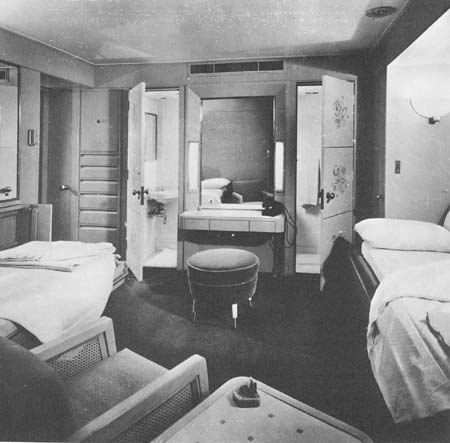 "Panama", Panama Steamship Lines, Loewy-styled (contemporary publication)
"Panama", Panama Steamship Lines, Loewy-styled (contemporary publication)
French Liners
A mail contract for the West Indies was awarded in 1858 to the Union Maritime, a daughter of the Orleans railway, but despite of their Rothschild connection they couldn't finance the project. Instead, the steamers of the "French Line", founded in 1855 by the Pereire brothers with its full title Compagnie Generale Maritime, then renamed Compagnie Generale Transatlantique (C.G.T.) , got in 1861 a mail contract including the Caribbean and the Isthmus of Panama. In 1862 their "Louisiane" made the first transatlantic crossing, bound for Mexico. The company operated towards the end of the 19th century the routes St. Nazaire - Fort de France - La Guaira (Venezuela) - Savanilla (Colombia) - Colon (Panama), St. Nazaire - Vera Cruz (Mexico) and Le Havre resp. Bordeaux - Colon. A connecting line Panama - Valparaiso had been maintained only between 1872 and 1874, then these ships were sold to the PSNC. During WWII the prestigious "De Grasse" (23,545 gt), sunk at Bordeaux and repaired, undertook services to the West Indies from 1944 (in 1953 she became the "Empress of Australia" and then the Italian "Venezuela"). In 1962 the CGT transferred the "Flandre", a modern one-funnel steamer of 20,477 tons, onto their Antilles and Venezuela route when the new "France" took her place on the North Atlantic. Now her hull being painted white, she joined the slightly similar "Antilles" of 1952.
After WWI, Panama had been served by ships of the Messageries Maritimes on the way to the French colonies in the Pacific. The South Atlantic however was the domaine of the Compagnie de Navigation Sud-Atlantique. Messageries Maritimes got in 1952/53 the M.S. "Caledonien" and "Tahitien" (12,614 gt) for Australia services passing the Panama Canal. When in 1977 that company together with the CGT became incorporated into the Compagnie Generale Maritime, regular passenger services to the Caribbean had already disappeared.
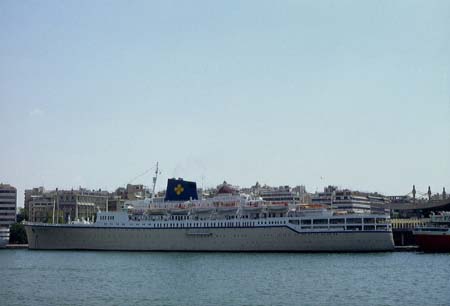
The former "Flandre" of CGT as "Pallas Athena" of Epirotiki, Piraeus 1992 (WS)
|
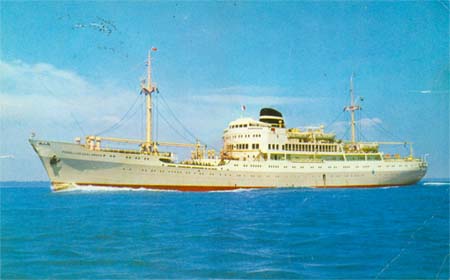
"Prins der Nederlanden", KNSM (old card, coll. WS)
|
Netherlands
The Netherlands possessed the islands of Curacao and Aruba off the coast of Venezuela and Paramaribo (Suriname) in South America. As early as in 1826 the auxiliary steamer "Curacao" of the Netherlands Navy traveled to Panamaribo and N.R.P. Bonsor stated that "she can be regarded as the first fully-fledged steamship to proceed from the Old World to the New ...". She had been the 436-ton "Calpe", commissioned by the American & Colonial S.N.Co. of England, sold before completion to the Dutch. She undertook from 1827 round trips to Paramaribo and the West Indies. Hendschel's Telegraph of 1856 showed a Dutch route to New Orleans. In 1883 the Royal Dutch West Indian Mail Line was founded and towards the end of the 19th century the route was Amsterdam - Paramaribo (Suriname) - Trinidad - La Guaira - Curacao - Port au Prince - New York. In 1912 the Royal Netherlands Steamship Co. or KNSM acquired the Dutch West Indian Mail Line. After WWI, in 1919, West Indies services were resumed. The Holland America Line adapted freighters for emigrant services, used on the West Indies and New Orleans route. Still in the 1960s Holland America maintained passenger-cargo services to the American West Coast. The KNSM provided between the wars passenger services from Amsterdam to the Caribbean. From 1950 they used small new passenger-cargo motor ships on a route to Suriname - Guyana - Trinidad and from 1957 the M.S. "Oranje Nassau" and "Prins der Nederlanden" (7,221 gt) on an Amsterdam - Trinidad - Curacao - Kingston line. At the end of the '70s only services to the Bahamas were listed with the remark: "Ports of call entirely dependent on cargo requirements".
Germany
Germany maintained already in the middle of the 19th century a steamer service by R.M. Sloman's Packetschiffahrt Hamburg - New York - New Orleans - Galveston. By 1867 the Hapag took up a regular service to New Orleans on the Gulf of Mexico, using aging tonnage. Two years later, the NDL followed with a line from Bremen via Havana with the newly-delivered "Frankfurt", "Hannover" and "Koeln" of about 2,580 tons each. The service of this popular trio was temporarily interrupted because of the German-French war of 1870/71. Another West Indian line, inaugurated after the end of hostilities, was opened with the "Kronprinz Friedrich", "Graf Bismarck" and "Albatross". Received newly from the yard, they were expected to attract additional custom, but proved to be a disappointment and the line was soon given up, the ships having been transferred to other routes. One reason for the retreat was the new West Indies service by Hapag inaugurated in 1871, but confined to cargo in 1879. Later, in 1905, Hapag started the Atlas-Linie from New York to Colon.
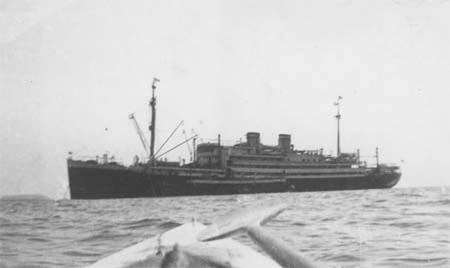 "Magdalena", later "Iberia", "Pobeda" (old card, coll. WS)
"Magdalena", later "Iberia", "Pobeda" (old card, coll. WS)
After WWI German shipping companies made great effort to increase their share in the Caribbean, the Gulf and the Central American trade. Hapag and H.C. Horn of Flensburg started a passenger service on a joint basis, but keeping separate identity. Another competing service by H. Schuldt was taken over by NDL. The North American West Coast was served by passenger-cargo ships. Hapag took in 1928 delivery of a sister-pair of modern motor ships of 9,880 tons, "Magdalena" and "Orinoco", and placed them on their West Indies route. The vessels won great popularity. On February 8,1934, the "Magdalena" stranded off-shore Curacao. After repair and extensive refit by which she lost her second funnel, the ship resumed under her new name "Iberia" its former service until the outbreak of WWII. After its end, she was handed over to the Soviet Union, renamed "Pobeda". Her sister, the "Orinoco", was requisitioned in Tampico by the Mexican government. Renamed "Puebla", she served during the war as a trooper for the U.S.A and finished her days as "Juan de Garay" under the flag of Argentina in 1961. In 1933 the Hapag took delivery of a pair of 12,000-ton motor-ships, the "Caribia" and the "Cordillera". The extravagance of their passenger facilities, including air-conditioning, made them soon the top-liners for the Central American area. Operating from Hamburg, intermediate calls were settled outward at Antwerp, Boulogne, Dover and Bilbao, homeward at Cherbourg, Plymouth and Amsterdam. M.S. "Caribia" entered the pages of technological history, when in 1935 in cooperation with the German Post for the first time a television reception has succeeded on board of a ship. About the same time, the cooperation between Hapag and Horn ceased on bilateral agreement. A considerable decline in passenger transport was caused by the Spanish Civil War (1936/39). The Hapag tried to compensate the losses by calling at Lisbon and by stationing the 2,400 ton-excursion steamer "Koenigin Luise" at Key West (Florida) for weekly tour trips. Preceding WWI, Hapag's chief manager Albert Ballin had carried in mind to crown the Caribbean operation field with a real top-service in shape of the three-funnel-liner "Admiral von Tirpitz" of 21,500 tons, whose route was intended to terminate in Chile by using the newly-opened Panama Canal. The outbreak of the war prevented this ambitious plan and finally the ship became the "Empress of Australia" of Canadian Pacific. Encouraged by the growing traveling demand after the war, Hapag revived the project decades later by placing an order for a new top-liner. The 16,000-ton motor-ship "Patria" of 1938 was to come out as one of the most advanced vessels of the time, featuring diesel-electric propulsion, full air-conditioning and improved passenger accommodations. Much praised was the vibration-free running. After two Northland cruises she went on her maiden voyage on the route to the South American west coast via Panama (for her further fate see chapter Hamburg-Sued).
Italy
Though Italy never possessed colonies in the Caribbean area, La Veloce took up in the 19th century a service Genoa - La Guaira - Cartagena - Colon - Port Limon, Costa Rica, and another one via Santo Domingo to Colon. In 1921 La Veloce was absorbed by Navigazione Generale Italiana and in 1931 by 'Italia' - Flotte Riunite. After WWII its successor 'Italia' Societa per Azioni di Navigazione was reconstituted in 1946. The passenger-cargo ship "Sebastiano Caboto" reopened the Valparaiso service via Panama in 1947. Also the Vancouver route was resumed with such modest passenger-cargo vessels. The Valparaiso route was maintained with the passenger-cargo Navigatori class. In the 60s the "Donizetti", "Verdi" and "Rossini" (13,225 gt), built in 1951 as "Australia", "Neptunia" and "Oceania" for the Lloyd Triestino, appeared on a route Genoa - La Guaira - Cartagena - Buena Ventura - Guayaquil - Callao - Arica - Antofagasta - Valparaiso, Chile. In 1975 the state-owned holding Finmare stopped transoceanic services.
After the war the Greek entrepreneur Eugenides had entered the Italian market with Home Lines and in 1949 he opened Central American services with the "Argentina" (ex "Bergensfjord"), in 1953 sold to Zim Lines. Flotta Lauro employed the "Sydney" and the "Roma" (14,687 gt, the former American "Atheling" and "Fencer") and around 1960 the M.S. "Surriento" (10,699 gt, the former "Barnett" of Grace Line), on routes to Barbados and La Guaira. Grimaldi Sicula Oceanica or Siosa Lines adapted in 1962 the M.S. "Irpinia" (13,204 gt, the former "Campana" of SGTM), for La Guaira services and in 1965 the M.S. "Caribia" (built in 1928 as "Vulcania" for Italian Lines), then employed between the Antilles, La Guaira and Jamaica. Costa Line or Linea "C" introduced in 1953 the "Franca C" (1914/5,426 gt, built as "Medina" for Mallory S.S.Co.) on a Venezuela route and in 1958 the "Federico C" (1975/20,416 gt) on the Argentina route, in the '60s also working to La Guaira and Miami. Still towards the end of the '70s the "Eugenio C" (c. 30,500 gt), the "Enrico C" (c. 15,000 gt), "Carla C" (the former "Flandre" of CGT), converted into a motor-ship, and the "Angelina" were listed by ABC Shipping Guide on regular Venezuela services. More and more however they changed into the cruise trade. In 1953 also the Sitmar Line of the Vlasov group appeared in the Caribbean with the "Fairsea", "Castel Felice", "Castel Bianco" (II) and "Castel Verde". Then the company concentrated more on the Australian emigrant trade (see chapter Indian Ocean/ Other Flags).
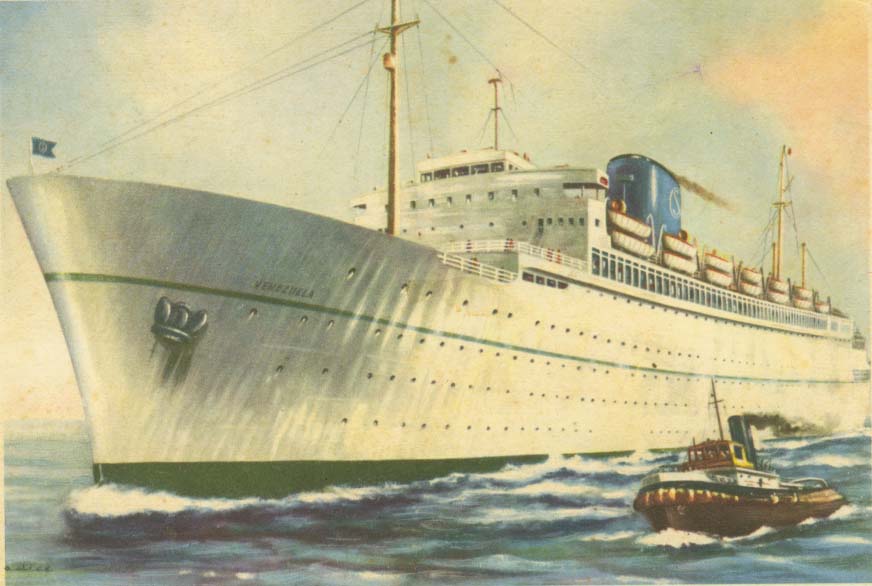
"Venezuela", Grimaldi Sicula Oceanica (old card, coll. WS)
|
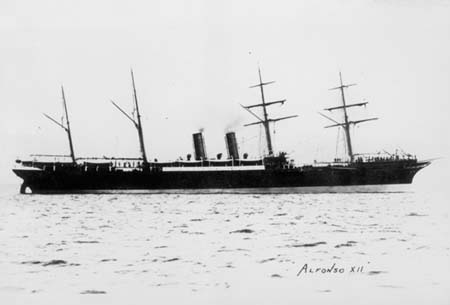
"Alfonso XII", Cia Trasatlantica (old card, coll. WS)
|
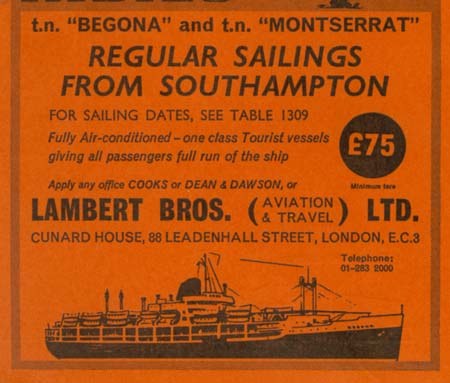 "Begona", Cia Trasatlantica ad (Cooks Continental Timetable 1968)
"Begona", Cia Trasatlantica ad (Cooks Continental Timetable 1968)
Spain
Spain had lost Central America, Colombia and Venezuela in the 1820's and '30s. Nevertheless, in 1850 Don Antonio Lopez y Lopez, Marques de Comillas of Cuba, founded a shipping firm which was awarded in 1861 the contract for mail and passenger services between Spain, Cuba, Puerto Rico and Santo Domingo. In 1881 the ailing business was saved by the Compania Trasatlantica. In 1886 a route Havana - New York was added. At the end of the 19th century the timetable showed services from Barcelona and also from Le Havre to Havana and Vera Cruz. In 1900 Trasatlantica opened a route Genoa - New York - Havana - Vera Cruz. Competitor on Latin American services was Pinillos, Izyquierdo y Cia. Apart from their main route to South America they operated also Havana and New Orleans services before suffering bankruptcy in the 1920s.
The Compania Trasatlantica had to stop services from Spain in 1936 on account of the Spanish civil war. They were resumed in 1939 and, after the next interruption by WWII, in 1946. The M.S. "Sastrutegui" and M.S. "Virginia de Churruca" (6,518 gt) were put to work on a complicated route to Vera Cruz and La Guaira, followed in 1953 by motor ships "Covadonga" and "Guadelupe" (10,226 gt) for a Bilbao - Vera Cruz - New York route and in 1957 by the "Begona" (10,139 gt) and the "Montserrat" (the former "Castel Bianco" and "Castel Verde" of Sitmar) for a Southampton - Venezuela service, which was listed still in the '60s. Within a few years all these services ended.
Other Flags
The Companhia Colonial de Navegacao of Portugal introduced still in 1953 the "Santa Maria" (20,906 gt) on a route Lisbon - La Guaira - Puerto Rico - Port Everglades, Florida. In 1961 the "Santa Maria" was captured in the Caribbean by opponents of the Portuguese dictator Salazar, organized by General Delgado. Under command of Henrique Galvao they intended to transfer the ship to Angola where a brutal war was started, lasting for decades. The pirates surrendered after twelve days at Recife, Brazil, and they were granted asylum.
For many shipping lines the first port-of-call after the Atlantic passage was the Danish island of St. Thomas. Before WWI the East Asiatic Co. of Denmark provided a passenger-cargo service connecting that outpost on the way to Suriname.
Canada signed in 1925 an agreement for an improvement of the services to the British Colonies in the Caribbean region. Canadian National Steamships introduced in 1928/29 the "Lady Rodney" (8,194 gt) and "Lady Somers" on a Montreal - Jamaica route. On the return tour the white dual purpose ships with the blue/white/red funnel transported bananas. Sisters of them served the Antilles and Guyana, until in 1952 the Caribbean services were withdrawn.
The Compagnie Maritime Belge acquired in 1960 Armement Deppe for Caribbean destinations. Still at the end of the '70s, that company provided passenger-cargo services Antwerp - Vera Cruz, noting: "Sailings entirely dependent upon cargo requirements".
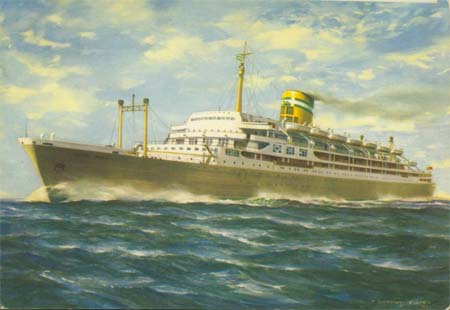
"Santa Maria", Cia. Colonial de Navegacao (old card, coll. WS)
|
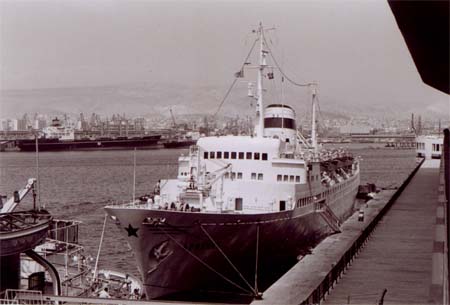
"Armeniya", Adzharia-class, Piraeus 1977 (WS)
|
After Fidel Castro's revolution of 1959, Cuba became a satellite of the Soviet Union. When in 1962 the eastern super power tried to put nuclear missiles in position just adjacent the doors of the United States, the world stood on the threshold of a third universal war. Years before, the Soviet Union had inaugurated a passenger service on the route Odessa - Havana. The service was operated by vessels of the "Mikhail Kalinin" class (4,722 gt) of 1958 and the "Adzharia" class (4,871 gt) of 1964, motor ships built at Wismar in East Germany with MAN diesel engines from West Germany. Nevertheless, Ships Monthly (May 2007) mentioned also 'little-published voyages to Cuba' by the "Ivan Franko" and "Aleksandr Pushkin" of the 19,000-ton 'Five Poets' class, built in the '60s at Wismar. In the '70s regular Cuba services disappeared from the timetables. In 1978 the "Admiral Nakhimov", the rebuilt former Hapag steamer "Berlin", conveyed participants in the World Youth Games to Havana. The "Ivan Franko" appeared once again in the Caribbean in 1994, chartered by the U.S. Military Sealift Command to convey Haitian refugees fleeing their island.
Luxury Tourism
In autumn 1934 a luxury hotel afloat was preparing for departure at Havana. The motorcars of the rich were load by winches and suddenly a strike broke out. Shots were heard, hungry crowds looted a warehouse. A man was arrested, accused of preparing to set fire on the ship, the "Morro Castle" (1931/11,520 gt) of the Ward Line, bound for New York. Five days later, after the captain had died under mysterious circumstances, the ship caught fire and stranded at Ashbury Park, New Jersey. The liner was a total loss and also the precious Rosy Diamond, on board together with the coffin of its owner, was lost.
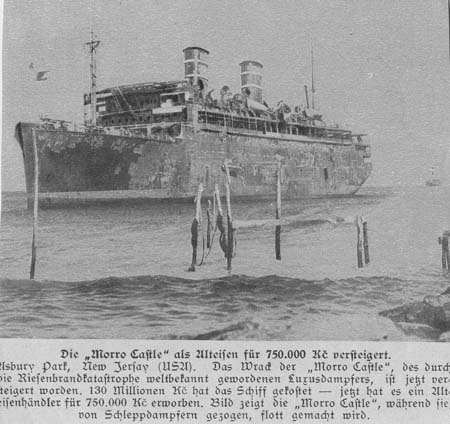
"Morro Castle", Ward Line, stranded at Ashbury Park (contemporary press, coll. HSch)
|
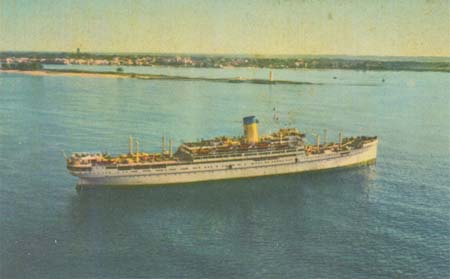
"Nassau", Incres Nassau Line (old card, coll. WS)
|
That story, making headlines, turned the attention to the new way of shipping for the rich and the beautiful. Passenger-cargo ships of the United Fruit Co. can be considered as forerunners of those services. Facing the competition by airlines, the company however dropped the passenger business. Another company which had become engaged in tourist trade was the Harrison Line, generally operating Gulf, Pacific and South American cargo services. Also the Atlantic Transport Co, belonging to the International Mercantile Marine (IMM) group, had entered the tourist market with passenger-cargo services. In 1935 they acquired the "Belgenland" (27,132 gt, commissioned already before WWI for the Red Star Line) and introduced her as "Columbia", then employed also on the Pacific and for cruises. The Incres Line bought in 1950 the "Rimutaka" (1923 / 16,576 gt, ex "Mongolia" of P&O) from the New Zealand Shipping Co. and renamed her "Europa", registered with Panama, for a New York - Antwerp service. In 1952 she was renamed "Nassau", opening a New York - Nassau - Havana route of Incres Nassau Line. She was sold to Nav. Turisticana Mexicana in 1961 and was scrapped in 1964, while the "Victoria" (ex "Dunnotar Castle" ) of Incres survived for some time with cruises. The Grace Line introduced still in 1950 the modern passenger steamers "Santa Paula" and "Santa Rosa" (15,366 gt) on a route New York - Curacao - La Guaira - Aruba - New York, offering also cruises. Later the "Santa Rosa" became "The Emerald" of Thomson Cruises and the "Santa Paula" was destroyed in 1991 during the Mideast Gulf War. Other companies offered only cruises in the Caribbean.
Apart from the Caribbean, also the natural beauty of the British-owned Bermudas has been discovered as an attractive holiday resort for well-situated American tourists.
The Quebec Steamship Co. , responsible already for mail services to the islands, opened in 1880 a passenger route New York - Bermudas - Trinidad, in 1905 upgraded with introduction of the "Bermudian". From 1910 competitors tried it with the former Hapag luxury cruise yacht "Oceana", but they failed (the ship became in 1916 the "Alfonso III" of Cia. Trasantlantica). After WWI the Quebec Steamship Co. was acquired by Furness, Withy & Co. of London. Adoption of the prohibition law to the U.S. constitution in the years 1920 to 1933 enhanced the attraction of the (British) Bermudas. A fleet of 1st-class luxury ships, known as 'the millionaire ships', was built for the Furness Bermuda Line with the "Bermuda" (1921/19,100 gt), "Monarch of Bermuda" (1931/22,424 gt, later "New Australia" of Shaw Savill, "Arkadia" of Greek Line) and the "Queen of Bermuda" (1933/22,575 gt). In 1949 the latter resumed regular New York - Bermuda services, in 1951 joined by the "Ocean Monarch" (13,581 gt), employed also on cruises. Moreover a quartette of new splendid Cunard liners, the "Carmania" "Franconia", "Carinthia" and "Sylvania" of the New York route, called regularly at the Bermudas.
Still after the end of the Furness Bermuda Line, the most attractive undertakings were the round-the-world tours passing the Panama Canal with proud ocean liners - above all Cunard's "Queen Elizabeth 2". In January 1971 she rendered assistance to the "Antilles" when that French liner had caught fire in the Caribbean. For the further development see chapter Cruises.
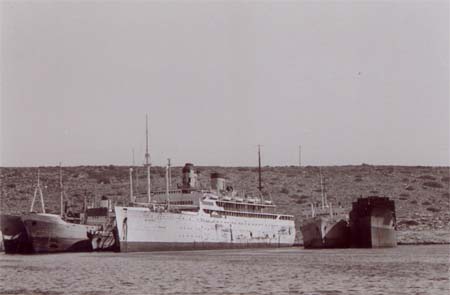
The former "Santa Rosa" (I) of Grace Line, as "Athina" of Typaldos, Salamis 1975 (WS)
|
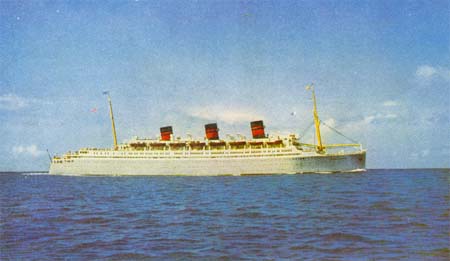
"Queen of Bermuda", Furness-Bermuda Line (old card, coll. WS)
|
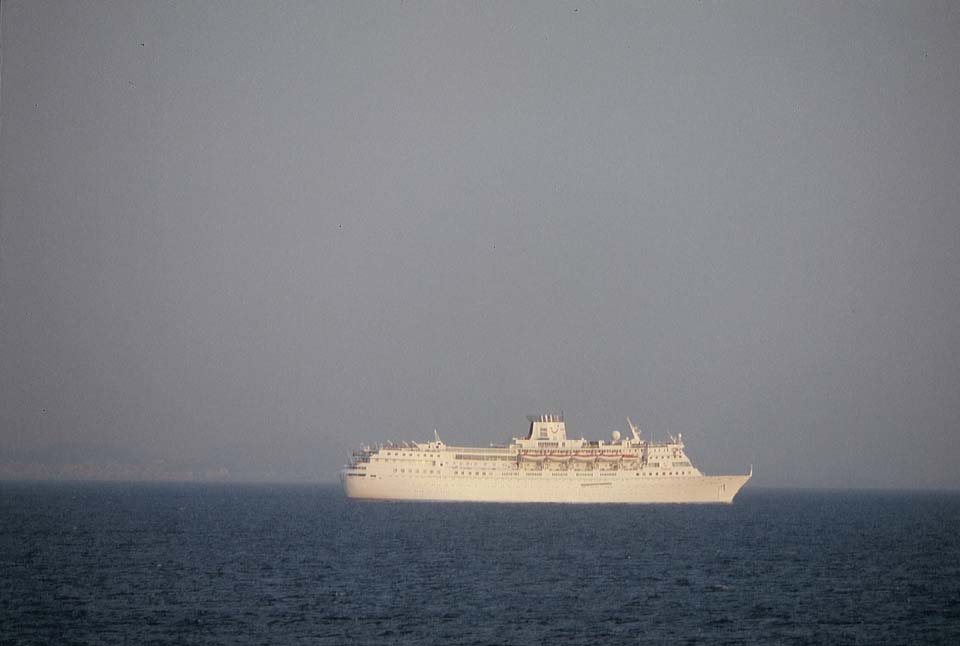
The former "Santa Rosa" (II) of Grace Line, as "The Emerald" leaving Piraeus, 2008 (WS)
Improvement of the Panama Canal
Among the biggest vessels which ever had passed the Panama Canal were the U.S. Navy battleships of the "New Jersey" class with a beam of 32.91 m and a cargo ship with a length-over-all of 299 m. Many new cruise ships are of "post-Panamax" size, but as passenger shipping's share is less than 5 percent, cargo vessels with 180,000 tons would be more important and the ACP (Autoridad del Canal de Panama) started an amelioration. One reason is the decades-old dream of a competing canal through Nicaragua between San Juan de Norte and the Pacific, passing Lake Nicaragua, intended for vessels of 350m loa and 250,000 gt. It would mean that cruise ships such as the "Freedom of the Seas" with a gross tonnage of 158,000 and 339 m loa could pass the Nicaragua Canal. The Panama Canal however is much shorter and in 2006 the population of Panama voted for a project raising its capacity by adding new locks until 2014. The project was carried out in an environmentally-friendly way, replacing lost rain forests by new forests in other areas.
|